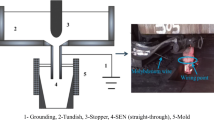Abstract
The study of submerged entry nozzle clogging dynamics mainly focuses on the interface wetting behavior. So as to understand the effect of the interface electric field on the wetting behavior between the immersion nozzle and the molten steel, electrowetting experiments and field industrial tests were performed. The results show that the wettability between the iron droplet and the nozzle constituent material can be improved by applying an electric field, and the solid–liquid wetting angle decreases with increasing voltage. There is an electric field at the interface between the submerged entry nozzle and molten steel during continuous casting, and the resulting electrowetting effect significantly changes the wetting behavior between the molten steel and the nozzle, which promotes the interaction between the two phases resulting in a large amount of deposits on the inner surface of the submerged entry nozzle, causing nozzle clogging.





Similar content being viewed by others
References
L.J. Trueba, Iron Steel Technol. 124, 3 (2013).
Z.Y. Deng, M.Y. Zhu, Y.L. Zhou, and D. Sichen, Metall. Mater. Trans. B 2015, 47 (2016).
S.H. Liu, X.F. Wang, X.J. Zuo, and Y.F. Wang, Rev. Métall. 73, 105 (2008).
H. Cui, Y.P. Bao, M. Wang, and W.S. Wu, Int. J. Miner. Metall. Mater. 157, 17 (2010).
Y. Vermeulen, B. Coletti, and B. Blanpain, ISIJ Int. 1234, 42 (2002).
J.K.S. Svensson, A. Memarpour, and S. Ekerot, Ironmak. Steelmak. 117, 44 (2017).
L.Y. Zhao and V. Sahajwalla, ISIJ Int. 1, 43 (2003).
Z.Y. Liu, L. Yuan, E.D. Jin, X. Yang, and J.K. Yu, Ceram. Int. 718, 45 (2019).
S. Jansson, V.J. Brabie, and P. Jonsson, Scand. J. Metall. 283, 34 (2005).
E.D. Bilbao, M. Dombrowski, and N. Traon, Adv. Sci. Technol. 264, 92 (2014).
M. Nobuo, A. Mitsuru, and T. Shigeani, Taikabutsu 331, 47 (1995).
Z.F. Tong, F.P. Wang, J.L. Qiao, and L.H. Luo, Nonferrous Met. Sci. Eng. 13, 7 (2016).
G. Christos and H. Michael, Int. J. Appl. Ceram. Technol. 469, 5 (2008).
B.J. Monaghan, S.A. Nightingale, and Q. Dong, Engineering 496, 2 (2010).
R. Boom, S. Riaz, and K.C. Mills, Ironmak. Steelmak. 21, 32 (2005).
S. Riaz and K.C. Mills, Ceram. Forum Int. E47, 79 (2002).
Y. Tsukaguchi, T. Kato, and S. Watanabe, Bull. Jpn. Inst. Met. 27, 50 (2011).
H.H. Wang, Y.J. Xu, K. Jiang, L. Ge, T.P. Qu, and D.Y. Wang, Mater. Rep. 96, 31 (2017).
X. Yang, J.K. Yu, Z.Y. Liu, X.H. Hou, and B.Y. Ma, Ceram. Int. 2881, 43 (2017).
X. Yang, Z.Y. Liu, and J.K. Yu, J. Mater. Proc. Technol. 341, 259 (2018).
J.E. Garay, U. Anselmi-Tamburini, and Z.A. Munir, Acta Mater. 4487, 51 (2003).
X.F. Zhang, J.D. Guo, and J.K. Shang, Scr. Mater. 513, 57 (2007).
X.F. Zhang, J.D. Guo, and J.K. Shang, J. Electr. Mater. 425, 38 (2009).
L.M. Zhang, N. Li, and H. Xing, Adv. Condens. Matter Phys. 1, 2018 (2018).
A. Memarpour, V. Brabie, and P. Jönsson, Ironmak. Steelmak. 229, 239 (2013).
F. Tehovni, J. Burja, B. Arh, and M. Knap, Metalurgija 371, 54 (2015).
K. Sasai and Y. Mizukami, ISIJ Int. 802, 34 (1994).
J.K. Yu, X. Yang, Z.Y. Liu, X.H. Hou, and Z.K. Yin, Ceram. Int. 13025, 43 (2017).
J.H. Kim, J.M. Lee, H.C. Shin, and Y.H. Paik, Metal. Mater. Int. 593, 9 (2003).
K. Mukai and M. Zeze, Steel Res. Int. 131, 74 (2003).
Acknowledgements
The project was funded by the National Natural Science Foundation of China (51874171, 51601035 and 51974154).
Author information
Authors and Affiliations
Corresponding authors
Additional information
Publisher's Note
Springer Nature remains neutral with regard to jurisdictional claims in published maps and institutional affiliations.
Electronic supplementary material
Below is the link to the electronic supplementary material.
Rights and permissions
About this article
Cite this article
Yang, X., Zhang, Y., Yuan, L. et al. Influence of Interface Electric Field on Wettability Between Molten Iron and Submerged Entry Nozzle Interface. JOM 72, 3521–3528 (2020). https://doi.org/10.1007/s11837-020-04240-2
Received:
Accepted:
Published:
Issue Date:
DOI: https://doi.org/10.1007/s11837-020-04240-2




